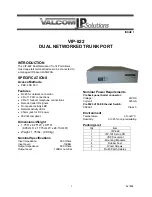
S
IMPLE
N
ETWORK
M
ANAGEMENT
P
ROTOCOL
3-45
Simple Network Management Protocol
Simple Network Management Protocol (SNMP) is a communication
protocol designed specifically for managing devices on a network.
Equipment commonly managed with SNMP includes switches, routers
and host computers. SNMP is typically used to configure these devices for
proper operation in a network environment, as well as to monitor them to
evaluate performance or detect potential problems.
The switch includes an onboard SNMP agent that continuously monitors
the status of its hardware, as well as the traffic passing through its ports. A
network management station can access this information using software
such as SMC EliteView. Access rights to the onboard agent are controlled
by community strings. To communicate with the switch, the management
station must first submit a valid community string for authentication. The
options for configuring community strings, trap functions, and restricting
access to clients with specified IP addresses are described in the following
sections.
Setting Community Access Strings
You may configure up to five community strings authorized for
management access. All community strings used for IP Trap Managers
should be listed in this table. For security reasons, you should consider
removing the default strings.
Command Attributes
•
SNMP Community Capability
– Indicates that the switch supports
up to five community strings.
•
Community String
– A community string that acts like a password
and permits access to the SNMP protocol.
Default strings: “public” (read-only), “private” (read/write)
Range: 1-32 characters, case sensitive
Summary of Contents for 6726AL2 FICHE
Page 2: ......
Page 20: ...CONTENTS xvi ...
Page 24: ...TABLES xx ...
Page 28: ...FIGURES xxiv ...
Page 38: ...INTRODUCTION 1 10 ...
Page 240: ...CONFIGURING THE SWITCH 3 190 ...
Page 502: ...TROUBLESHOOTING B 4 ...
Page 515: ......
















































